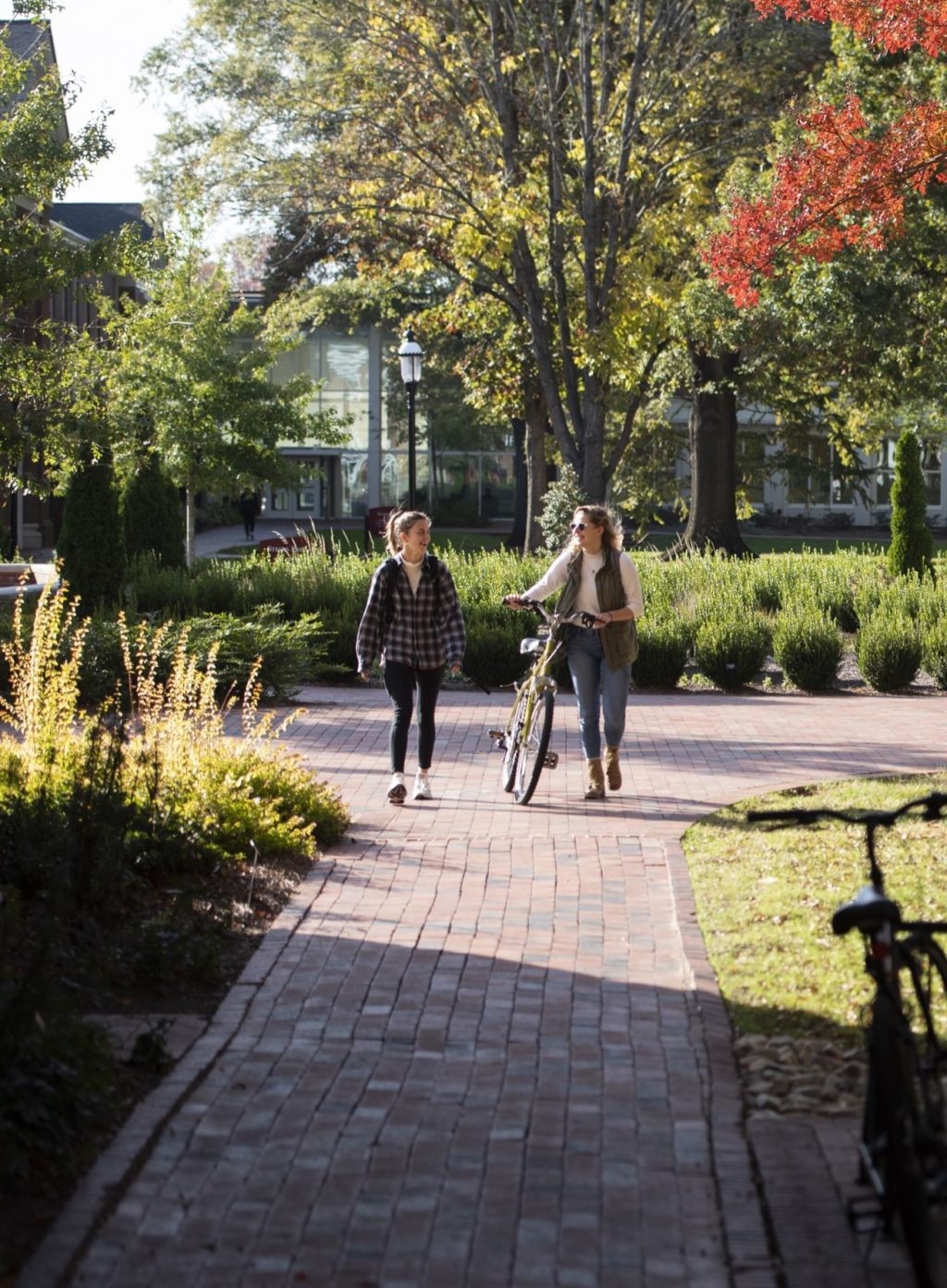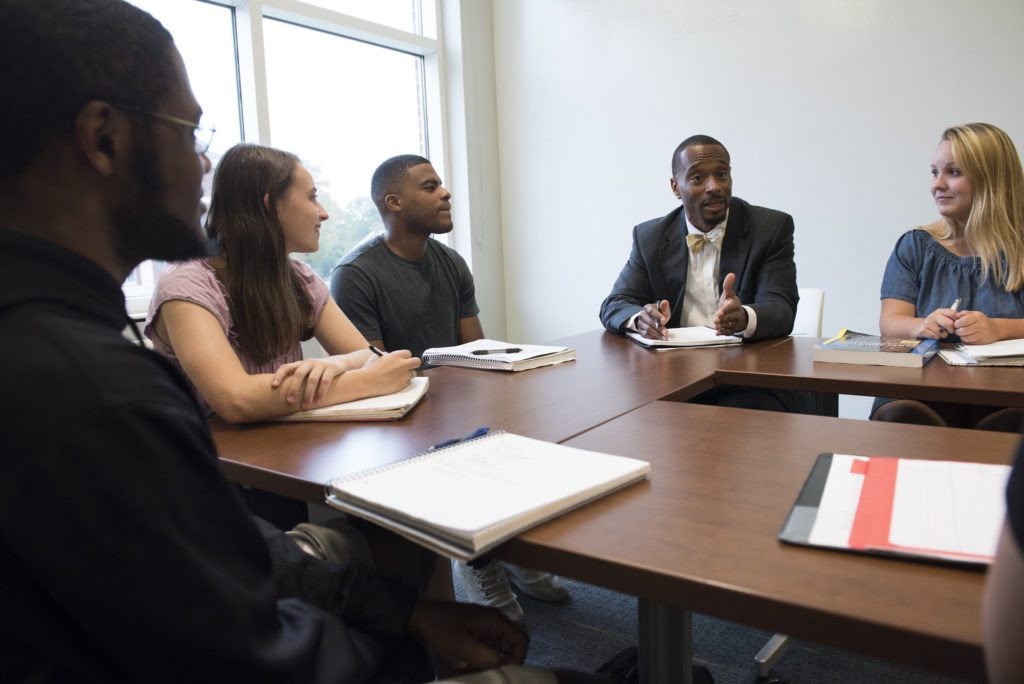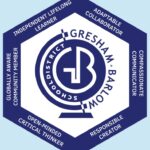What Is A Learning Community? It’s a group of individuals who share common educational goals and actively collaborate to enhance their learning experience. LEARNS.EDU.VN believes in fostering these environments, providing a space where learners connect, share insights, and grow together. Discover how this approach transforms education into a vibrant, engaging journey, promoting knowledge sharing and educational support networks.
1. Defining Learning Communities: A Collaborative Approach
A learning community is more than just a group of students taking the same classes; it’s a dynamic partnership between students, faculty, and staff, designed to overcome obstacles to academic success. These communities restructure the traditional curriculum to foster deeper understanding and integration of knowledge.
Faith Gabelnick, Jean MacGregor, Roberta S. Matthews, and Barbara Leigh Smith, in their seminal work, describe a learning community as:
“Any one of a variety of curricular structures that link together several existing courses – or actually restructure the curricular material entirely – so that students have opportunities for deeper understanding and integration of the material they are learning, and more interaction with one another and their teachers as fellow participants in the learning enterprise” (1990, p. 19).
This definition emphasizes the intentional restructuring of curriculum to connect courses and promote intellectual exchange between faculty and students. Learning communities address structural issues within universities that can hinder effective teaching and learning. Collaboration, active learning, team teaching, and interdisciplinary themes are integral to their success.
Nancy Shapiro and Jodi Levine expanded on Alexander Astin’s view of learning communities, highlighting their ability to:
“Build a sense of group identity, cohesiveness, and uniqueness; to encourage continuity and the integration of diverse curricular and co-curricular experiences; and to counteract the isolation that many students feel” (Astin, 1985, p. 161).
Shapiro and Levine (1999) outlined essential characteristics that learning communities share:
- Organizing students and faculty into smaller groups
- Encouraging curriculum integration
- Helping students build academic and social support networks
- Providing a setting for socialization into college expectations
- Bringing faculty together in meaningful ways
- Focusing on learning outcomes for both faculty and students
- Offering community-based academic support programs
- Providing a lens for examining the first-year experience.
Lenning et al. (2013) define a learning community as:
“An intentionally developed community that exists to promote and maximize the individual and shared learning of its members. There is ongoing interaction, interplay, and collaboration among the community’s members as they strive for specified common learning goals” (Lenning, et al., 2013, p. 7).
George Kuh (1996) broadens the definition to include any educationally purposeful activity that aligns with the institution’s educational goals and a student’s aspirations. He and his co-author further describe a learning community as:
“A formal program where groups of students take two or more classes together, [that] may or may not have a residential component” (Zhao and Kuh, 2004, p. 119).
Kuh identifies four generic forms of learning communities: curricular, classroom, residential, and student-type.
In summary, a learning community seeks to integrate learning across courses and engage students with significant, real-world questions. Students work closely with peers and professors, exploring topics through various disciplinary lenses, often linking liberal arts and professional courses or incorporating service learning.
2. The Impact of Learning Communities: A High-Impact Practice
Learning communities are considered a high-impact practice due to their effectiveness in enhancing student learning and engagement. These activities share characteristics that make them particularly beneficial.
According to Chun-Mei Zhao and George D. Kuh (2004, p. 124), participation in learning communities is consistently linked with:
- Improved student academic performance
- Increased engagement in educationally fruitful activities
- Enhanced gains associated with college attendance
- Greater overall satisfaction with the college experience.
Lenning and Ebbers (1999, p. 51-52) highlight numerous benefits for college students in well-designed learning communities:
| Benefit | Description |
|---|---|
| Improved GPAs | Students in learning communities often achieve higher grade point averages. |
| Higher Retention Rates | Students are more likely to stay enrolled and complete their programs. |
| Increased Satisfaction | Students report greater satisfaction with their educational experiences. |
| Reduced Academic Probation | Fewer students face academic probation due to improved performance. |
| Enhanced Learning Quality and Quantity | Students demonstrate deeper understanding and retain more information. |
| Validated Learning | Students feel their learning is recognized and valued. |
| Improved Academic Skills | Students develop stronger study habits, research abilities, and critical thinking skills. |
| Increased Self-Esteem | Students gain confidence in their abilities and potential. |
| Greater College Involvement | Students become more actively involved in campus life and extracurricular activities. |
| Increased Writing and Speaking Opportunities | Students have more chances to practice and refine their communication skills. |
| Deeper Learning Engagement | Students show greater interest and commitment to their studies. |
| Enhanced Ability to Meet Academic and Social Needs | Students find it easier to balance their academic and social lives. |
| Greater Intellectual Richness | Students gain a broader and more nuanced understanding of the world. |
| Intellectual Empowerment | Students feel empowered to take control of their learning and intellectual development. |
| More Complex Thinking | Students develop the ability to analyze complex issues and form well-reasoned opinions. |
| Openness to Diverse Ideas | Students become more receptive to new perspectives and ways of thinking. |
| Bridging Academic and Social Environments | Students learn to connect their academic studies with their social experiences. |
| Improved Social and Academic Connectedness | Students feel more connected to their peers, faculty, and the institution as a whole. |


These benefits illustrate how learning communities foster a supportive and enriching educational environment.
3. Research-Informed Practices: Building Effective Learning Communities
George Kuh (2008, p. 19-20) emphasizes the importance of high-impact activities and recommends that institutions:
“Make it possible for every student to participate in at least two high-impact activities during his or her undergraduate program, one in the first year, and one taken later in relation to the major field… Ideally, institutions would structure the curriculum and other learning opportunities so that one high-impact activity is available to every student every year.”
Schroeder and Mable (1994, p. 183) offer six principles for developing successful learning communities:
- Learning communities are small, unique, and cohesive units with a shared sense of purpose and strong peer influence.
- Student interaction is characterized by involvement, investment, influence, and identity.
- Learning communities have a defined territory that supports ongoing interaction and social stability.
- Learning communities are primarily student-centered, fostering student responsibility for their learning.
- Effective learning communities result from collaborative partnerships between faculty, students, and staff.
- Learning communities exhibit clear values and expectations for active participation.
Gabelnick, et al. (1990, p. 51) provide guidelines for creating high-achieving learning communities:
- Ensure broad support from faculty and staff.
- Establish stable leadership and administrative support.
- Select an appropriate design and theme that aligns with students’ goals.
- Choose a faculty team with complementary skills.
- Manage enrollment expectations and faculty workload.
- Develop effective recruitment, marketing, and registration strategies.
- Secure adequate funding, space, and teaching resources.
Golde & Pribbenow (2000) investigated faculty experiences in residential learning communities and offer recommendations for fostering collaboration between faculty and staff:
- Faculty are deeply concerned about undergraduate education and want to connect with students.
- Faculty are drawn to interdisciplinary and innovative education.
- Faculty are both excited and concerned about being accepted into the learning community.
Barriers to faculty participation include:
- Time constraints: Faculty reward systems must acknowledge and account for the time commitment required for learning community involvement.
- Lack of awareness and respect for the contributions of student affairs professionals.
Golde and Pribbenow conclude that faculty are the best advocates for recruiting other faculty into learning communities and that it is crucial to involve faculty in planning and provide them with well-defined roles.
The National Resource Center for Learning Communities highlights three essential components:
- A strategically defined cohort of students taking courses together.
- Robust, collaborative partnerships between academic affairs and student affairs.
- Explicitly designed opportunities to practice integrative and interdisciplinary learning.
The Center emphasizes that learning communities should be designed to align with an institution’s unique goals and priorities.
4. Key Components of a Thriving Learning Community
To foster a successful learning community, consider these key elements:
- Shared Goals: Clearly defined objectives that guide the community’s activities and provide a sense of purpose.
- Active Participation: Encouraging all members to contribute ideas, share knowledge, and engage in discussions.
- Open Communication: Creating a safe space for honest and respectful dialogue.
- Collaboration: Working together on projects, assignments, and activities to leverage diverse skills and perspectives.
- Mutual Support: Providing encouragement, assistance, and constructive feedback to one another.
- Reflection: Taking time to assess progress, identify areas for improvement, and celebrate achievements.
By incorporating these elements, learning communities can create a dynamic and supportive environment where individuals thrive academically and personally.
5. Embedded and Emerging Questions for Research, Practice, and Theory
Taylor et al. (2003) identified key future directions for learning community research and assessment:
- Identifying and assessing a broader scope of learning community outcomes for students, faculty, and institutions.
- Exploring the specific pedagogical and structural characteristics that lead to positive outcomes.
- Pursuing longitudinal inquiry to examine the long-term impact of learning communities.
- Improving presentations and publications about learning community research.
Lenning & Ebbers (1999, p. 88) suggest further areas of study:
- Which student learning communities and combinations thereof are most effective?
- How do we optimize the performance and effectiveness of different types of student learning communities?
- How do we motivate faculty to participate fully in student learning communities?
- What do we know about the characteristics of students who do not participate, and how to motivate them?
The allocation of resources also raises concerns. Universities are often evaluated on the quality of students they admit, rather than the quality of education they provide. This can lead to a focus on competitive admissions rather than practices that improve learning. As Greater Expectations (2002, p. 17) notes, the current definition of quality in higher education does little to encourage schools to create supportive learning environments for diverse student populations.
6. Learning Communities in the Digital Age
The rise of online learning has opened new avenues for creating learning communities. Digital tools and platforms enable learners to connect, collaborate, and share resources regardless of their physical location.
Benefits of Digital Learning Communities:
- Accessibility: Online communities can reach learners from diverse backgrounds and geographic locations.
- Flexibility: Learners can participate at their own pace and on their own schedule.
- Scalability: Online platforms can accommodate a large number of participants.
- Rich Resources: Digital tools enable the sharing of multimedia content, interactive simulations, and other learning resources.
- Enhanced Communication: Online forums, chat rooms, and video conferencing facilitate real-time interaction and collaboration.
Strategies for Building Effective Digital Learning Communities:
- Establish Clear Guidelines: Set expectations for online behavior, communication, and participation.
- Facilitate Interaction: Encourage learners to ask questions, share ideas, and provide feedback.
- Provide Regular Feedback: Offer constructive criticism and support to help learners improve.
- Recognize Contributions: Acknowledge and celebrate the achievements of community members.
- Foster a Sense of Belonging: Create opportunities for learners to connect with one another on a personal level.
7. How to Get Involved in a Learning Community
If you’re interested in joining a learning community, here are some steps you can take:
- Research: Explore different types of learning communities and identify one that aligns with your interests and goals.
- Contact: Reach out to the organizers or facilitators of the learning community to learn more about their activities and requirements.
- Attend: Participate in meetings, workshops, or other events to get a feel for the community and its members.
- Contribute: Share your knowledge, skills, and ideas to help the community achieve its goals.
- Engage: Actively participate in discussions, projects, and other activities.
- Network: Connect with other members of the learning community to build relationships and expand your learning network.
8. The Role of LEARNS.EDU.VN in Fostering Learning Communities
LEARNS.EDU.VN recognizes the transformative power of learning communities and actively supports their development. We offer a range of resources and services to help learners connect, collaborate, and thrive.
Our Commitment:
- Providing a Platform: We offer a digital platform where learners can create and join learning communities.
- Facilitating Interaction: We provide tools and features that enable learners to communicate, share resources, and collaborate on projects.
- Curating Content: We curate high-quality educational content that supports the goals of learning communities.
- Connecting Experts: We connect learners with experienced educators and mentors who can provide guidance and support.
- Promoting Best Practices: We share best practices for building and sustaining effective learning communities.
At LEARNS.EDU.VN, we believe that learning is a social process. By fostering learning communities, we empower learners to achieve their full potential and make a positive impact on the world.
9. Overcoming Challenges in Learning Communities
While learning communities offer numerous benefits, they also present certain challenges that need to be addressed to ensure their success.
Common Challenges:
- Scheduling Conflicts: Coordinating schedules can be difficult, especially for learners with diverse commitments.
- Personality Clashes: Disagreements and conflicts can arise due to differences in personality, learning styles, or work habits.
- Unequal Participation: Some members may dominate discussions while others remain silent.
- Lack of Motivation: Members may lose interest or become disengaged over time.
- Technical Issues: Technical difficulties can disrupt online communication and collaboration.
Strategies for Overcoming Challenges:
- Establish Clear Roles and Responsibilities: Define the roles and responsibilities of each member to ensure accountability and prevent conflicts.
- Develop Communication Protocols: Establish guidelines for communication to promote respectful and productive dialogue.
- Facilitate Conflict Resolution: Provide mechanisms for resolving disputes and addressing grievances.
- Offer Incentives: Provide rewards and recognition to motivate members and encourage participation.
- Provide Technical Support: Offer technical assistance to help members overcome technical difficulties.
10. The Future of Learning Communities: Trends and Innovations
Learning communities are constantly evolving to meet the changing needs of learners and the demands of the 21st century. Here are some emerging trends and innovations in the field:
- Personalized Learning: Tailoring learning experiences to meet the individual needs and preferences of each learner.
- Competency-Based Education: Focusing on the acquisition of specific skills and knowledge rather than seat time.
- Microlearning: Breaking down complex topics into smaller, more manageable chunks of information.
- Gamification: Incorporating game-like elements into learning activities to increase engagement and motivation.
- Artificial Intelligence: Using AI to personalize learning, provide feedback, and automate administrative tasks.
- Virtual Reality: Creating immersive learning experiences that simulate real-world scenarios.
- Blockchain Technology: Using blockchain to create secure and transparent records of learning achievements.
These trends and innovations have the potential to transform learning communities and make them more effective, engaging, and accessible.
FAQ: Your Questions About Learning Communities Answered
- What is the primary goal of a learning community? To enhance learning through collaboration and shared experiences.
- Who typically participates in learning communities? Students, faculty, and staff who are committed to creating a supportive and enriching learning environment.
- Are learning communities only for academic purposes? No, they can also focus on personal growth, professional development, or community engagement.
- Can learning communities exist online? Absolutely! Digital tools and platforms have made online learning communities increasingly popular and effective.
- How do I find a learning community that’s right for me? Research different communities and look for one that aligns with your interests, goals, and learning style.
- What are some of the benefits of participating in a learning community? Improved academic performance, increased engagement, greater satisfaction, and enhanced social connections.
- What if I don’t have time to commit to a formal learning community? Look for informal opportunities to connect with other learners, such as study groups or online forums.
- How can I contribute to a learning community? Share your knowledge, skills, and ideas, participate in discussions, and offer support to other members.
- What are some of the challenges of learning communities, and how can they be addressed? Scheduling conflicts, personality clashes, and unequal participation can be addressed through clear communication, defined roles, and effective facilitation.
- What resources does LEARNS.EDU.VN offer for learning communities? We provide a digital platform, curated content, expert connections, and best practices for building and sustaining effective learning communities.
Conclusion: The Enduring Value of Learning Communities
Learning communities represent a powerful approach to education, fostering collaboration, engagement, and shared learning experiences. By connecting with others, sharing knowledge, and working towards common goals, learners can achieve their full potential and make a meaningful impact on the world.
At LEARNS.EDU.VN, we are committed to supporting the development of thriving learning communities. We believe that by fostering these environments, we can transform education and empower learners to achieve their dreams.
Are you ready to embark on a journey of collaborative learning and personal growth? Visit learns.edu.vn today to explore our resources, connect with other learners, and discover the power of learning communities. Contact us at 123 Education Way, Learnville, CA 90210, United States, or via Whatsapp at +1 555-555-1212. Let’s learn and grow together!
